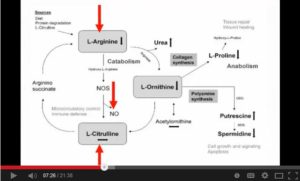The purpose of this blog post titled The Truth About L-Arginine is to counter the misinformation used to negate the  benefits of this amino acid to your overall health.
benefits of this amino acid to your overall health.
Most of the misinformation comes from the rapidly expanding market for nitric oxide supplements. And this misinformation usually comes from companies that use beet root extract to harness the nitrate/nitrite pathway for the creation of nitric oxide.
The misinformation usually takes two approaches:
“L-arginine is a semi-essential amino acid that can help the body produce nitric oxide but supplementation doesn’t work in all people, especially those over 40.” This is taken from the Berkeley FAQ section of their website and makes it seem that for those over the age of 40 the L-arginine pathway is disfunctional.
The use of nitric oxide test strips to demonstrate improved nitric oxide production. And while there is a correlation, these test strips only measure nitrite levels in the saliva.
To help you better understand how misleading these two approaches are I put together the following video titled
The Truth About L-Arginine
Now for those who don’t have the time to watch the video, here’s the cliff notes version of The Truth About L-Arginine:
-
L-Arginine fuels 7 different metabolic pathways that are key to optimal health. And this applies to all people no matter their age.
-
Nitric oxide production from the amino acid L-arginine via the NOS enzymes of your endothelium is THE primary pathway for the production of nitric oxide. This operates at all ages and can be increased when your endothelium is given the correct ingredients.
-
The nitrate/nitrite pathway is a valid pathway for the creation of nitric oxide, but is also a short lived pathway. Just like the L-arginine pathway, it needs other ingredients to extent its ability to produce nitric oxide over longer periods of time.
-
Anyone telling you that L-arginine is bad for you, especially if you’re over the age of 40, either doesn’t understand the Nobel Prize Winning Research around the production of nitric oxide, or is being disingenuous because they’re trying to sell you on a nitrate/nitrite product.
-
The use of nitric oxide test strips for the measurement of nitric oxide is deceptive because these test strips only measure nitrite levels in the saliva. Then they make a correlation to nitric oxide production. Thus no direct measurement of nitric oxide. And if you’re using the L-arginine pathway for the production of nitric oxide, then you will not produce nitrites that can be picked up by these test strips. Which is very misleading.
-
Finally there is a discussion about the John Hopkins study that blamed L-arginine for more post heart attacks for those who had a heart attack. The problem with this study was the use of HCl as a carrier molecule, which lowers potassium levels in the body. This effects muscle relaxation, which can then trigger a heart spasm leading to a heart attack.
Well there you have it. The real truth and not some marketing ploy to get you to buy a product.
I’m a firm believer in nitric oxide therapy for improving cardiovascular health and circulation.
Both the L-arginine and nitrate/nitrite pathways are valid for the production of nitric oxide. However, both are short lived pathways and require other ingredients for the long term production of nitric oxide.
And it is the long term production of nitric oxide that is key to improving your cardiovascular health. Which is another video and blog post.
Leave a Reply
You must be logged in to post a comment.